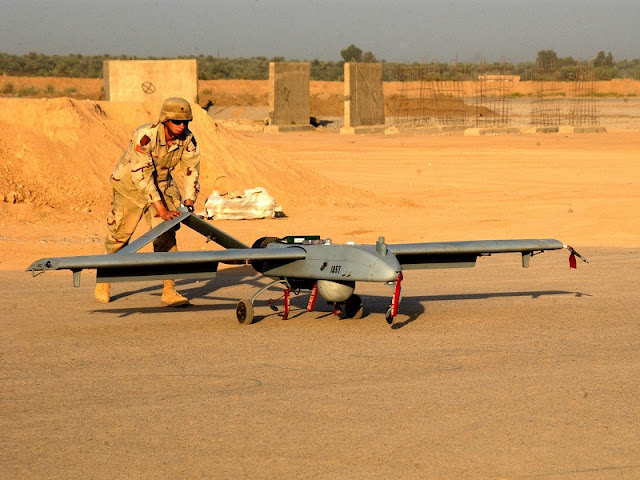DARPA makes progress on paper and polymer drones that degrade in days after delivering cargo
by noreply@blogger.com (brian wang) from NextBigFuture.com on (#29MF8)
DARPA will take a page from Mission Impossible. Mission Impossible had messages on tape or disc that would self destruct after being played. DARPA will make drones made of polymers or paper that will disappear (deconstruct) after delivering a 3 pound cargo.
DARPA's ICARUS program is developing autonomous air-delivery vehicles capable of delivering intact a 3-pound payload with 10 meters accuracy with respect to a GPS-programmed location. Within hours of payload delivery, the vehicle, which should be no more than 3 meters in its longest dimension, must physically vanish. The 26-month program will culminate in a final Government field-test of fully vanishing, precision air-delivery prototypes.
The primary technical categories of the ICARUS program are aerodynamics and materials. It will take creative aerodynamic design and materials engineering to minimize overall capability tradeoffs that the interplay of these two interacting arenas is likely to require. For example, engineering materials that are stable enough to meet flight specifications, yet unstable enough to undergo the vanishing requirement, is a tall order.
Within a larger context, the ICARUS program addresses the fundamental question of whether large, functional structures can be deliberately designed to disappear soon after their mission is completed. If this capability can be developed, it could have impacts in many core areas where a leave-behind would have environmental and/or unintended logistical consequences.

DARPA has now provided the San Francisco-based research team at Otherlab with funding to build what would surely be the most tech-savvy paper plane to take to the skies
The Aerial Platform Supporting Autonomous Resupply Actions (APSARA) systems are a heavy-duty cardboard gliders that can be deployed from an aircraft like a C-17 cargo plane, by the hundreds. Star Simpson, hardware developer on the project, tells us that they can then glide up to around 55 mi (88 km) away from the drop point, before circling in and making a precise landing with the cargo in tow.
"We have done tests releasing our aircraft from 1,000 ft (304 mt) and proved their ability to turn at waypoints and to land within close range of a specific location," Simpson tells New Atlas.
Once the goods have arrived, the drones biodegrade in a matter of days. And because it is a glider without motors and rotors, it means that all of the onboard electronics, courtesy of DARPA's VAPR program, go with it.
The current models carry 1 kg (2.2 lb), but should easily could scale up to carrying 10 kg (22 lb).


Read more










DARPA's ICARUS program is developing autonomous air-delivery vehicles capable of delivering intact a 3-pound payload with 10 meters accuracy with respect to a GPS-programmed location. Within hours of payload delivery, the vehicle, which should be no more than 3 meters in its longest dimension, must physically vanish. The 26-month program will culminate in a final Government field-test of fully vanishing, precision air-delivery prototypes.
The primary technical categories of the ICARUS program are aerodynamics and materials. It will take creative aerodynamic design and materials engineering to minimize overall capability tradeoffs that the interplay of these two interacting arenas is likely to require. For example, engineering materials that are stable enough to meet flight specifications, yet unstable enough to undergo the vanishing requirement, is a tall order.
Within a larger context, the ICARUS program addresses the fundamental question of whether large, functional structures can be deliberately designed to disappear soon after their mission is completed. If this capability can be developed, it could have impacts in many core areas where a leave-behind would have environmental and/or unintended logistical consequences.

DARPA has now provided the San Francisco-based research team at Otherlab with funding to build what would surely be the most tech-savvy paper plane to take to the skies
The Aerial Platform Supporting Autonomous Resupply Actions (APSARA) systems are a heavy-duty cardboard gliders that can be deployed from an aircraft like a C-17 cargo plane, by the hundreds. Star Simpson, hardware developer on the project, tells us that they can then glide up to around 55 mi (88 km) away from the drop point, before circling in and making a precise landing with the cargo in tow.
"We have done tests releasing our aircraft from 1,000 ft (304 mt) and proved their ability to turn at waypoints and to land within close range of a specific location," Simpson tells New Atlas.
Once the goods have arrived, the drones biodegrade in a matter of days. And because it is a glider without motors and rotors, it means that all of the onboard electronics, courtesy of DARPA's VAPR program, go with it.
The current models carry 1 kg (2.2 lb), but should easily could scale up to carrying 10 kg (22 lb).


Read more